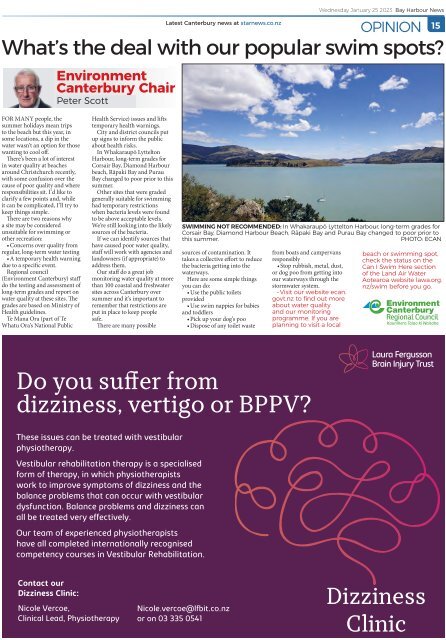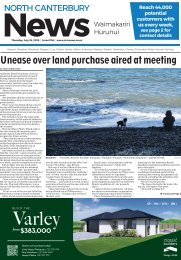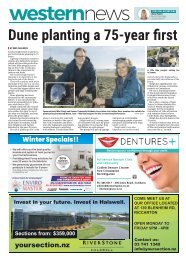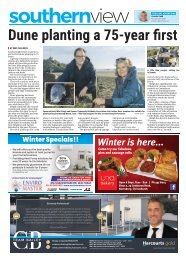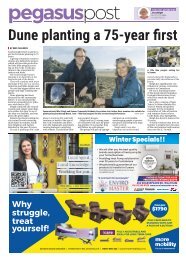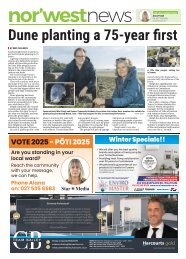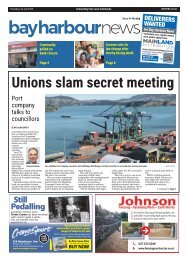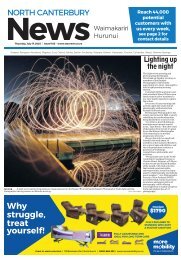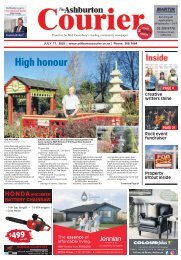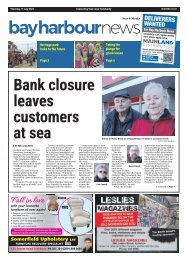Bay Harbour: January 25, 2023
Transform your PDFs into Flipbooks and boost your revenue!
Leverage SEO-optimized Flipbooks, powerful backlinks, and multimedia content to professionally showcase your products and significantly increase your reach.
since Environment Canterbury<br />
climate-change emergency<br />
Do you suffer from<br />
dizziness, vertigo or BPPV?<br />
These Canterbury issues does – from can be treated with vestibular<br />
physiotherapy.<br />
freshwater management to<br />
Vestibular to air quality, and rehabilitation also regional<br />
As<br />
therapy<br />
an organisation, a<br />
we<br />
specialised<br />
have<br />
leadership – has a climate change<br />
also made significant progress in<br />
form focus. of therapy, in which addressing physiotherapists<br />
our own greenhousegas<br />
emissions, with our<br />
Currently, under the Resource<br />
work<br />
Management<br />
to improve<br />
Act, regional<br />
symptoms Christchurch of dizziness building receiving and a the<br />
balance councils are required problems only to adapt “market-leading” energy efficiency<br />
that can occur with vestibular<br />
to climate change, not mitigate rating of 5.0 out of 6 in the year<br />
dysfunction. it – that responsibility Balance is the problems to February on and the National dizziness can<br />
Government’s, but could change. Australian Built Environment<br />
all be treated very effectively. Rating System New Zealand.<br />
Our<br />
existing<br />
team<br />
policies<br />
of<br />
and<br />
experienced<br />
plans already 184 solar panels which can<br />
physiotherapists<br />
contribute to reduced emissions. generate more than 55,000<br />
have In declaring all completed the climate internationally kilowatt hours of electricity recognised per<br />
emergency, the Council noted it year.<br />
competency would continue to show courses leadership in Vestibular There has been a Rehabilitation.<br />
26% reduction<br />
Contact our<br />
Dizziness Clinic:<br />
Nicole Vercoe,<br />
Clinical Lead, Physiotherapy<br />
Nicole.vercoe@lfbit.co.nz<br />
or on 03 335 0541<br />
Wednesday <strong>January</strong> <strong>25</strong> <strong>2023</strong> <strong>Bay</strong> <strong>Harbour</strong> News<br />
FOR and enhance MANY people, that work. the<br />
Health fleet Service) hybrid or issues long-range and lifts electric<br />
summer That work holidays included mean setting trips temporary by 2022. health Carbon warnings. emissions from<br />
to up the a climate-change beach but this year, integration<br />
City air travel and district across the councils organisation put<br />
some programme locations, in a the dip Long-term in the Plan up are signs offset to inform via our the own public biodiversity<br />
water 2018-28, wasn’t ensuring an option climate for those change about programmes. health risks.<br />
wanting was actively to cool considered off. across In According Whakaraupō to a Lyttelton Madworld report<br />
workstreams, There’s been a increasing lot of interest visibility <strong>Harbour</strong>, in 2019, long-term our gross grades emissions for were<br />
in of water the science quality and at beaches what we know Corsair 2<strong>25</strong>3 tonnes <strong>Bay</strong>, Diamond of carbon <strong>Harbour</strong> dioxide<br />
around about the Christchurch impact of climate recently, beach, (CO2) Rāpaki equivalent, <strong>Bay</strong> and compared Purau with<br />
with change some on confusion Canterbury, over and the liaising <strong>Bay</strong> removals changed of to 7883 poor tonnes prior to of this CO2-<br />
cause on the of issue poor with quality iwi and where regional summer. equivalent through our efficiency<br />
responsibilities partners, other sit. local I’d authorities like to Other efforts sites and that from were forestry graded planting<br />
clarify and central a few points government. and, while generally across 2700 suitable hectares. for swimming<br />
it can As be an complicated, organisation, I’ll we try have to had temporary The changing restrictions climate will pose<br />
keep also things made significant simple. progress in when many bacteria risks to levels life were and livelihood found<br />
addressing There are two our reasons own greenhousegas<br />
site emissions, may be considered with our<br />
We’re we have still looking seen how into occasional, the likely SWIMMING metres per NOT second RECOMMENDED: (cumecs). In transport. Whakaraupō Lyttelton <strong>Harbour</strong>, long-term grades for<br />
why to be in Canterbury. above acceptable In recent levels. years flow peaking at 3990 cubic hydrogen, to power our public<br />
a<br />
unsuitable Christchurch for swimming building receiving or a sources but extreme, of the bacteria. weather events have Corsair The <strong>Bay</strong>, protection Diamond scheme <strong>Harbour</strong> has been Beach, Rāpaki When my <strong>Bay</strong> predecessor and Purau Steve <strong>Bay</strong> changed to poor prior to<br />
other “market-leading” recreation: energy efficiency If had we huge can identify effects on sources residents that and this designed summer. to defend Christchurch Lowndes retired as chair of<br />
PHOTO: ECAN<br />
rating • Concerns of 5.0 over out of quality 6 in the from year have infrastructure caused poor around water quality, the South from a flood of as much as 6500 this council late last year, he<br />
regular, to February long-term the water National testing staff Island. will work with agencies and sources<br />
cumecs.<br />
of contamination. It from boats highlighted and campervans some of the big beach or swimming spot,<br />
Australian • A temporary Built health Environment warning landowners The driest (if appropriate) parts of our to region, takes a<br />
Environment<br />
collective effort<br />
Canterbury’s<br />
to reduce responsibly<br />
changes on the way. He was check the status on the<br />
due Rating to a System specific New event. Zealand. address along them.<br />
Marlborough coast and the bacteria<br />
leadership<br />
getting<br />
of biodiversity<br />
into the<br />
and<br />
• Stop<br />
optimistic<br />
rubbish, metal,<br />
we would<br />
dust,<br />
be able to Can I Swim Here section<br />
Regional The building’s council features include Our across staff much do a of great the job Canterbury waterways.<br />
biosecurity programmes is also<br />
or dog<br />
deal<br />
poo<br />
with<br />
from<br />
the<br />
getting<br />
“pressing<br />
into<br />
issues” of the Land Air Water<br />
(Environment 184 solar panels Canterbury) which can staff monitoring Plains, are water expected quality to at get more even Here<br />
underpinned<br />
are some simple<br />
by climate-change<br />
things our waterways<br />
climate change<br />
through<br />
and<br />
the<br />
sustainability. Aotearoa website lawa.org.<br />
do<br />
generate<br />
the testing<br />
more<br />
and<br />
than<br />
assessment<br />
55,000<br />
of than<br />
drier.<br />
100<br />
North-westerly<br />
coastal and freshwater<br />
storms are you can<br />
concerns.<br />
do:<br />
stormwater<br />
I share<br />
system.<br />
his confidence. As a nz/swim before you go.<br />
long-term<br />
kilowatt hours<br />
grades<br />
of<br />
and<br />
electricity<br />
report on<br />
per<br />
sites<br />
predicted<br />
across Canterbury<br />
to become<br />
over<br />
more intense, • Use<br />
Canterbury’s<br />
the public toilets<br />
distinct braided<br />
• Visit<br />
community,<br />
our website<br />
and as<br />
ecan.<br />
a council,<br />
water<br />
year.<br />
quality at these sites. The summer and it’s important to provided<br />
govt.nz to find out more<br />
grades<br />
There<br />
are It’s has<br />
based<br />
been<br />
on<br />
a Ministry<br />
26% year reduction<br />
of since Environment Canterbury<br />
remember with torrential that restrictions alpine rainstorms<br />
are • Use rivers swim and nappies unique for wetlands babies face<br />
about we water are taking quality some bold steps to<br />
turning our braided rivers into many challenges. The rivers form<br />
Health guidelines.<br />
put in place to keep people and toddlers<br />
and our<br />
ensure<br />
monitoring<br />
we are in a better place to<br />
per staff member in emissions roaring rapids, fuelling landslides a vital ecological link and provide<br />
Te Mana Ora (part of Te safe.<br />
• Pick up your dog’s poo programme.<br />
cope with<br />
If<br />
the<br />
you<br />
changing<br />
are<br />
climate<br />
since 30<br />
Whatu Ora’s declared<br />
June 2010. We now have<br />
National Public There a are climate-change many possible<br />
• Dispose of any toilet waste emergency<br />
and causing widespread erosion. an abundant food supply and planning<br />
and the<br />
to<br />
tests<br />
visit<br />
it<br />
a<br />
will<br />
local<br />
set us. But<br />
access to electric and hybrid<br />
Canterbury’s coastal<br />
nesting grounds for 26 species of there will always be a need to do<br />
vehicles JENNY and hope HUGHEY to have explains half our what communities will be threatened native birds – most classified as by sea-level more. rise this century and<br />
the council has been doing.<br />
Environment<br />
The formal declaration of a<br />
state of climate emergency across Canterbury Chair<br />
Canterbury was one of the most<br />
serious, and colourful, moments<br />
Jenny Hughey<br />
in the regional council’s more than<br />
30-year history.<br />
and enhance that work.<br />
fleet hybrid or long-range electric<br />
A year ago this Saturday,<br />
That work included setting by 2022. Carbon emissions from<br />
at 11.49am, Environment<br />
Canterbury became New Zealand’s<br />
first council to proclaim such an<br />
emergency, formally dedicating<br />
itself to consideration of climate<br />
change at the heart of all it does.<br />
The declaration highlighted<br />
that all the work Environment<br />
biodiversity and biosecurity,<br />
transport and urban development<br />
Even in ‘adapt mode’ many<br />
of Environment Canterbury’s<br />
Environment<br />
Canterbury Chair<br />
Jenny Peter Scott Hughey<br />
on climate-change and do so<br />
without adding new programmes<br />
at ratepayers’ expense. It also gave<br />
staff a clear mandate to continue<br />
up a climate-change integration<br />
programme in the Long-term Plan<br />
2018-28, ensuring climate change<br />
was actively considered across<br />
workstreams, increasing visibility<br />
of the science and what we know<br />
about the impact of climate<br />
change on Canterbury, and liaising<br />
on the issue with iwi and regional<br />
partners, other local authorities<br />
and central government.<br />
The building’s features include<br />
per staff member in emissions<br />
since 30 June 2010. We now have<br />
access to electric and hybrid<br />
vehicles and hope to have half our<br />
Latest Canterbury news at starnews.co.nz<br />
by sea-level rise this century and<br />
our productive and protected land<br />
jeopardised by the arrival and<br />
spread of new, exotic weeds and<br />
pests from warmer climates.<br />
All these eventualities have<br />
to be planned and prepared for,<br />
and Environment Canterbury<br />
will remain in the vanguard of<br />
these climate change efforts.<br />
One example is the $40 million<br />
Waimakariri River flood<br />
protection project, completed<br />
late last year. The network of<br />
floodgates and stopbanks will<br />
protect half a million people and<br />
$8 billion of community and<br />
business assets from a possible<br />
“super flood”.<br />
The last major flood was in<br />
December 1957, when parts<br />
of Coutts Island in Belfast and<br />
Kainga were swamped by river<br />
air travel across the organisation<br />
are offset via our own biodiversity<br />
programmes.<br />
According to a Madworld report<br />
in 2019, our gross emissions were<br />
2<strong>25</strong>3 tonnes of carbon dioxide<br />
(CO2) equivalent, compared with<br />
removals of 7883 tonnes of CO2-<br />
equivalent through our efficiency<br />
efforts and from forestry planting<br />
across 2700 hectares.<br />
The changing climate will pose<br />
many risks to life and livelihood<br />
in Canterbury. In recent years<br />
we have seen how occasional,<br />
but extreme, weather events have<br />
had huge effects on residents and<br />
infrastructure around the South<br />
Island.<br />
The driest parts of our region,<br />
along the Marlborough coast and<br />
across much of the Canterbury<br />
Plains, are expected to get even<br />
drier. North-westerly storms are<br />
predicted to become more intense,<br />
with torrential alpine rainstorms<br />
turning our braided rivers into<br />
roaring rapids, fuelling landslides<br />
and causing widespread erosion.<br />
Canterbury’s coastal<br />
communities will be threatened<br />
threatened and facing increased<br />
pressures due to river system<br />
change.<br />
Wetlands are also ecosystems<br />
at-risk nationally and regionally,<br />
degraded by draining, damming<br />
and diversion affecting their<br />
ability to sequester carbon,<br />
cleanse freshwater and mitigate<br />
flooding, as well as impacting on<br />
biodiversity and mahinga kai.<br />
With biosecurity, we are<br />
putting greater emphasis on the<br />
risks of new pests establishing<br />
in Canterbury. Warming<br />
temperatures, changing soils and<br />
new land uses mean new weeds<br />
especially, will be able to gain a<br />
better foothold across the region.<br />
More broadly, we have to<br />
curb reliance on fossil fuels and<br />
find environmentally suitable<br />
alternatives, such as electricity and<br />
our productive and protected land<br />
jeopardised by the arrival and<br />
spread of new, exotic weeds and<br />
pests from warmer climates.<br />
All these eventualities have<br />
to be planned and prepared for,<br />
and Environment Canterbury<br />
will remain in the vanguard of<br />
these climate change efforts.<br />
One example is the $40 million<br />
Waimakariri River flood<br />
protection project, completed<br />
late last year. The network of<br />
floodgates and stopbanks will<br />
protect half a million people and<br />
$8 billion of community and<br />
business assets from a possible<br />
“super flood”.<br />
The last major flood was in<br />
December 1957, when parts<br />
of Coutts Island in Belfast and<br />
Kainga were swamped by river<br />
flow peaking at 3990 cubic<br />
metres per second (cumecs).<br />
The protection scheme has been<br />
designed to defend Christchurch<br />
from a flood of as much as 6500<br />
cumecs.<br />
Environment Canterbury’s<br />
leadership of biodiversity and<br />
biosecurity programmes is also<br />
underpinned by climate-change<br />
concerns.<br />
Canterbury’s distinct braided<br />
rivers and unique wetlands face<br />
many challenges. The rivers form<br />
a vital ecological link and provide<br />
an abundant food supply and<br />
nesting grounds for 26 species of<br />
native birds – most classified as<br />
OPINION 15<br />
What’s the deal with our popular swim spots?<br />
threatened and facing increased<br />
pressures due to river system<br />
change.<br />
Wetlands are also ecosystems<br />
at-risk nationally and regionally,<br />
degraded by draining, damming<br />
and diversion affecting their<br />
ability to sequester carbon,<br />
cleanse freshwater and mitigate<br />
flooding, as well as impacting on<br />
biodiversity and mahinga kai.<br />
With biosecurity, we are<br />
putting greater emphasis on the<br />
risks of new pests establishing<br />
in Canterbury. Warming<br />
temperatures, changing soils and<br />
new land uses mean new weeds<br />
especially, will be able to gain a<br />
better foothold across the region.<br />
More broadly, we have to<br />
curb reliance on fossil fuels and<br />
find environmentally suitable<br />
alternatives, such as electricity and<br />
hydrogen, to power our public<br />
transport.<br />
When my predecessor Steve<br />
Lowndes retired as chair of<br />
this council late last year, he<br />
highlighted some of the big<br />
changes on the way. He was<br />
optimistic we would be able to<br />
deal with the “pressing issues” of<br />
climate change and sustainability.<br />
I share his confidence. As a<br />
community, and as a council,<br />
we are taking some bold steps to<br />
ensure we are in a better place to<br />
cope with the changing climate<br />
and the tests it will set us. But<br />
there will always be a need to do<br />
more.<br />
Dizziness<br />
Clinic


